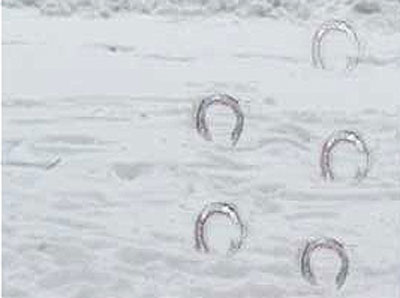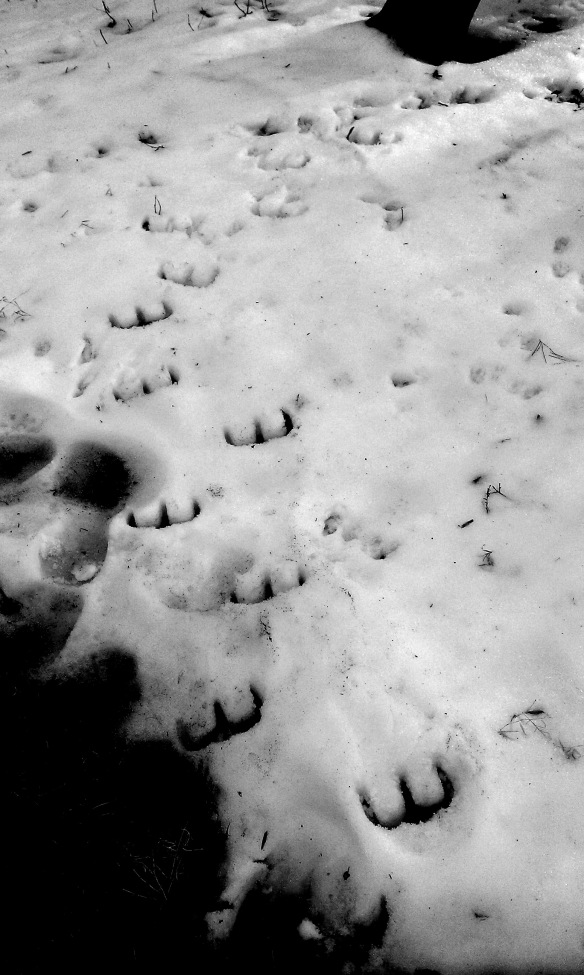
Is the devil visiting Devon, England ?
The Devil’s Footprints was the name given to a peculiar phenomenon that occurred in Devon, England on 8 February 1855. After a light snowfall, during the night, a series of hoof-like marks appeared in the snow. These footprints, measuring 1.5 to 2.5 inches wide and eight inches apart, continued throughout the countryside for a total of over 100 miles, and, although veering at various points, for the greater part of their course followed straight lines. Houses, rivers, haystacks and other obstacles were travelled straight over, and footprints appeared on the tops of snow-covered roofs and high walls which lay in the footprints’ path, as well as leading up to and exiting various drain pipes of as small as a four inch diameter. Reports of similar anomalous, obstacle-unheeded footprints exist from other parts of the world, although none is of such a scale as that of the case of the Devil’s Footprints.
Incident
 On the night of 8–9 February 1855 and one or two later nights, after a light snowfall, a series of hoof-like marks appeared in the snow. These footprints, measuring 1.5 to 2.5 inches wide and eight inches apart, continued throughout the countryside for a total of over 100 miles, and, although veering at various points, for the greater part of their course followed straight lines.Houses, rivers, haystacks and other obstacles were travelled straight over, and footprints appeared on the tops of snow-covered roofs and high walls which lay in the footprints’ path, as well as leading up to and exiting various drain pipes of as small as a four inch diameter.
On the night of 8–9 February 1855 and one or two later nights, after a light snowfall, a series of hoof-like marks appeared in the snow. These footprints, measuring 1.5 to 2.5 inches wide and eight inches apart, continued throughout the countryside for a total of over 100 miles, and, although veering at various points, for the greater part of their course followed straight lines.Houses, rivers, haystacks and other obstacles were travelled straight over, and footprints appeared on the tops of snow-covered roofs and high walls which lay in the footprints’ path, as well as leading up to and exiting various drain pipes of as small as a four inch diameter.
The area in which the prints appeared extended from Exmouth, up to Topsham, and across the river Exe to Dawlish and Teignmouth. R.H. Busk, in an article published in Notes and Queries decades later, stated that footprints also appeared further afield, as far south as Totnes and Torquay, and that there were other reports of the prints further afield in Weymouth (Dorset) and even Lincolnshire. In each case, the prints would go on for miles and miles before abruptly stopping.
There were also attendant rumours about sightings of a “devil-like figure” in the Devon area during the scare. Many townspeople armed themselves and attempted to track down the beast responsible, without success.
Theories
Many explanations have been put forward for the incident. Some investigators are sceptical that the tracks really extended for over a hundred miles, arguing that no-one would have been able to follow their entire course in a single day. Another reason for scepticism, as Joe Nickell points out, is that the eye-witness descriptions of the footprints varied from person to person.
Similar incidents
On the night of March 12, 2009, more strange marks, corresponding to those left in 1855, were found again in Devon. Comparative analysis shows similar markings. Reports of similar anomalous, obstacle-unheeded footprints exist from other parts of the world, although none is of such a scale as that of the case of the Devil’s Footprints.
Among the high mountains of that elevated district where Glenorchy, Glenlyon and Glenochay are contiguous, there have been met with several times, during this and also the former winter, upon the snow, the tracks of an animal seemingly unknown at present in Scotland. The print, in every respect, is an exact resemblance to that of a foal of considerable size, with this small difference, perhaps, that the sole seems a little longer, or not so round; but as no one has had the good fortune as yet to have obtained a glimpse of this creature, nothing more can be said of its shape or dimensions; only it has been remarked, from the depth to which the feet sank in the snow, that it must be a beast of considerable size. It has been observed also that its walk is not like that of the generality of quadrupeds, but that it is more like the bounding or leaping of a horse when scared or pursued. It is not in one locality that its tracks have been met with, but through a range of at least twelve miles. —The Times, March 14, 1840
Originally posted 2016-04-29 20:27:53. Republished by Blog Post Promoter

![devil-footprints-mystery[1]](https://coolinterestingnews.com/wp-content/uploads/2013/03/devil-footprints-mystery1.jpg)












